LISTEN ON YOUR FAVE PLATFORM: Apple // Audible // Google
Description: In this episode, we are talking about the importance of having an “end of work” routine and why you need one, especially when you work from home. This isn’t just for you and your sanity, this is for your family!
When I was newly married, I worked in downtown Seattle, and if I didn’t plan my commute just right, it could be the difference between taking 40 minutes to get home and two hours. So yep, I learned the exact moment when I had to be out of my office and walking to my car. I used those drives to listen to books or have a serious car-karaoke session. Sometimes I’d even just pray or rattle off reasons I was grateful, but the point is there was this very obvious transition between work and home because I had that car ride.
For the last 14 years, though, my work has always been just down the hall from my bedroom. My commute literally takes me 11 steps. I counted it this morning, and that might be very similar for you. The line has blurred between where work ends and where home begins. Add to that, the fact that our work is literally in our pocket at all times, and the boundaries can get pretty blurry!
And that’s why I want to talk about an end-of-work routine: Something that signifies the workday is over, but doesn’t leave you feeling terrible because you didn’t do enough. But what if we could do the work better in less time so that we can have those boundaries and feel really good about it? (Spoiler: we CAN!)
This will help:
👉 Anyone who wants better work-life balance
👉 Those who can’t seem to shut work off
👉 Work from home moms to shift gears more easily
In this episode:
0:40 Why You Need an End-Of-Work Routine
3:29 Where the 40 Hour Work Week Came From
5:28 Work-Life Balance DOES Exist
8:33 Setting Office Hours
9:40 The Power of an Alarm
10:10 Final Wrap Up
11:06 Daily Five and Time Blocking
12:51 Make a Physical Switch
WORK-LIFE BALANCE ACTUALLY DOES EXIST
Searching for work-life balance has become a whole industry. In fact, when I googled the phrase, there were over two billion search results. The problem with work-life balance is that the concept can be a little elusive, and that’s left a lot of people shouting that it is a myth and therefore does not exist. This idea drives me absolutely crazy and makes me so upset because I remember hearing that when I was first trying to figure this out, and it made me feel hopeless.
I remember feeling that if this is as good as it gets, I am doomed. But I believe that work-life balance absolutely, unequivocally DOES exist, but we have to understand what it is.
Work-life balance, simply put, is feeling that all areas of your life are aligned and that they feel good. It’s not about the perfect equal amount of time being spent on every single task because that’s ridiculous. It’s not about being perfect in everything, which is also ridiculous. It is more about prioritizing our core values.
CREATING AN END-OF-WORK ROUTINE
Creating an end-of-work routine is an intentional practice that signals to us and to others the switch from work to home. That intentional switch has been a game changer for me in being able to actually achieve that elusive work-life balance. Here are 5 things you can do to create an end-of-work routine and get you on the path to better work-life balance.
1. SET OFFICE HOURS
Working whenever and wherever sounds like freedom, but I promise – it can quickly turn into a trap! It’s important to define office hours. I even go as far as to post those hours on my door so that everyone can see them. It does two really incredible things for me. Number one, it removes a lot of interruptions. Someone might come down the hallway, they want to ask mom something, they look and they think, “oh, she’s coming out at noon for lunch. Okay, then I can wait.” It also allows everyone to know that I’m done for the day at two o’clock (or whatever that time is) and if I don’t come out, they are allowed to come get me and keep me accountable.
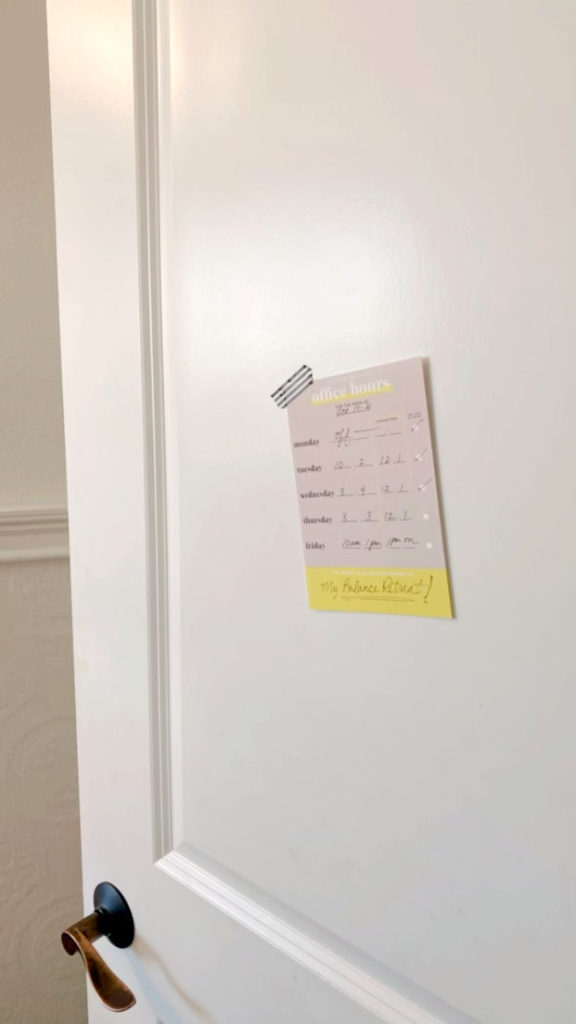
The posted office hours create the boundary and minimize interruptions so that I can be more productive when I am actually supposed to be working.
2. USE AN ALARM
My number two tip is using an alarm to give yourself a warning to wrap things up. Now, this timeframe needs to be whatever works for you. For some, they might feel like they actually need a two or three system alarm. You might need one that says you have 60 minutes left, one at 30 minutes, and then one that goes off with 10 minutes left to work. Or maybe you just need a 15 minute reminder that helps you wrap everything up. I really like having one that helps me to realize I need to wrap up whatever I’ve been working on and then one more that signifies my final wrap up.
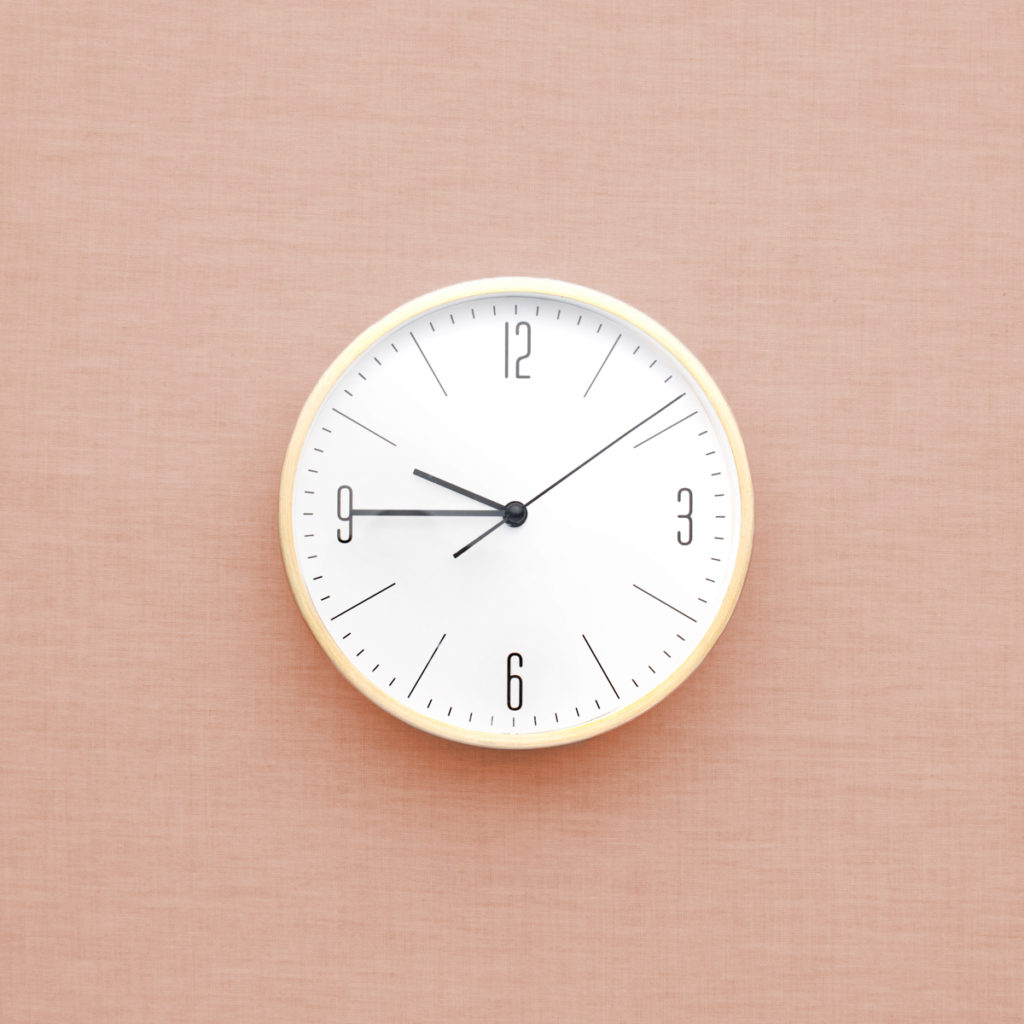
3. GIVE YOURSELF SPACE FOR A FINAL WRAP UP
The final wrap-up is basically a reset. It’s resetting your desk, your desktop, etc. If you use my desktop organizer, which is free, you can grab it right here. This is a great time to just reset your desktop organizer.
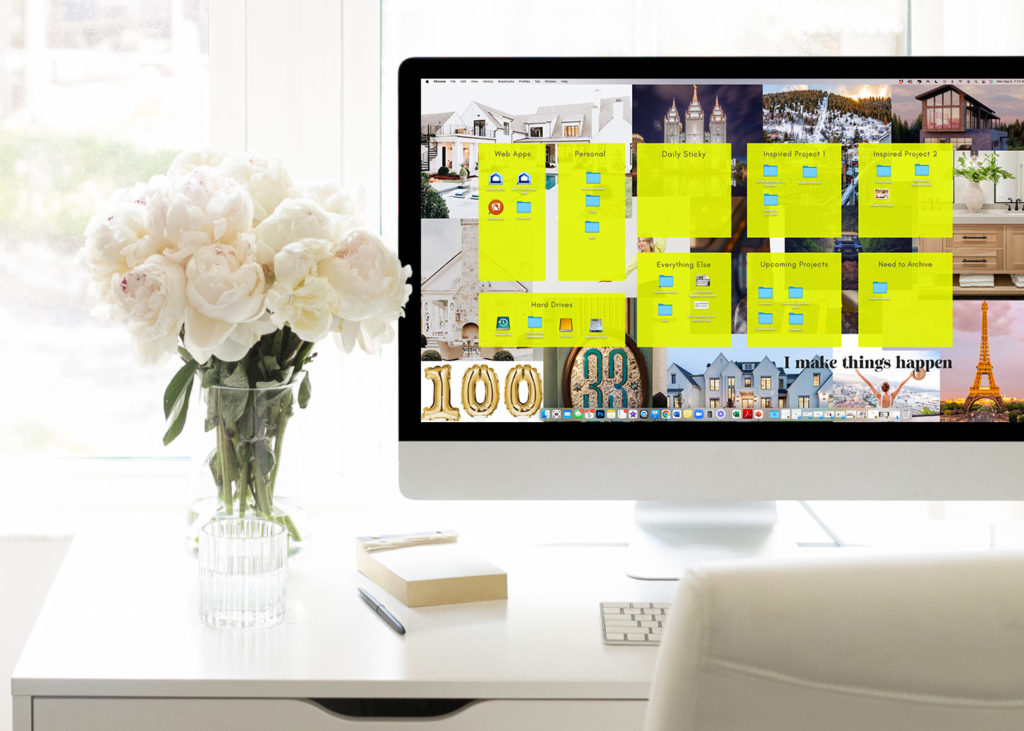
I’m going to put away all my pens and notepads, take any dishes to the kitchen… On my desktop, I’m going to reorganize my folders, move things from inspired project to archive or wherever it needs to go. And then I’m also going to update my Daily Five, which I’ll talk about in a minute.
Taking a few minutes to reset everything, means when I step back into work next time, I feel ready instead of chaotic.
4. PLAN FOR TOMORROW AND TIME BLOCK
Number four is about writing out tomorrow’s tasks and then time-blocking them. I am a big fan of only writing three to five things per day: The Daily Five. Now, you can absolutely do more than that, but there are never more than five items on my list because it’s really hard to get more than five things done. You don’t want to end up feeling like you weren’t effective or productive or successful.
I have a larger list that’s kind of my brain dump list, which includes all the other things that need to happen, but that’s not what I’m looking at for the day. For the day, I only want to look at three to five things. I look at about how long I think each one is going to take and I time block them.
This does two powerful things. One, it helps me to assess and make sure that what I’m planning to get done tomorrow I can actually fit into the day. And two, it gives me a good sense of what everything is going to look like.
5. PHYSICAL SWITCH
Once all of that is done, I usually have a final alarm that goes off to signal the end of the day. Now, when I was working outside of the home this is when a physical switch would occur. I would shut everything off, leave the building, and commute home. Working from home looks different, but making a physical shift to leave work can be a game changer.
Think like Mr. Rogers when he changed from his day shoes to his home shoes or from the blazer to the cardigan. Yours could be switching into slippers. I love when I get to signify that the day is over and I switch in to my slippers. We are signifying to our brains that there is a shift by making a change in what we’re wearing. Think of all the movies where she walks in the door and kicks off her stilettos. When we work from home, we don’t really need to be wearing stilettos, but what could we do to signify this physical switch that says we’re turning off work mode and turning on home mode?
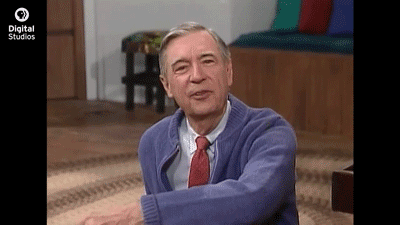
Another idea for taking this even further would be to actually give yourself a commute. And I don’t mean you have to get in the car and drive around, although you can if you want to. This could be taking the dog for a walk. So you carve out 10 minutes and your commute becomes walking the dog around the block.
And so when you leave, you’re leaving your office and you’re walking around the block. And when you’re coming to your door, now you’re coming home. I think it’s really important to have a moment to be in the in between.
We need the “commute.” That could even mean it’s just a transition where you sit for a minute and take some deep belly breaths, or take a few minutes to tidy up the house before you jump into the next thing. We need the resets. We need something that signifies that we are changing hats.
I know with these tips and by creating an end of work day routine, that you can introduce more work life balance into your life. I would love to know what is one actionable step that you can take from this episode to balance the busy just a little bit better?
And if you feel like you’re a lost cause, that you’re always running just a little bit too behind to have any transition or routine, take it from me: You can change. I was perpetually feeling that tightness and anxiousness, feeling that there was never enough time rushing from one thing to another, running out of the office sometimes, literally, because I needed to rush to the next thing. It is possible to change and to create better.
If I can change, so can you.
BEFORE YOU GO! Here are some helpful links and mentions from today’s show:
>>> Get my Desktop Organizer here
Find out where you’re losing time every day and if your business is taking more time than it should.
Enroll in my FREE course and learn how to drop an entire work day a week!
Come follow Leah on Instagram for more daily tips to balance the busy.
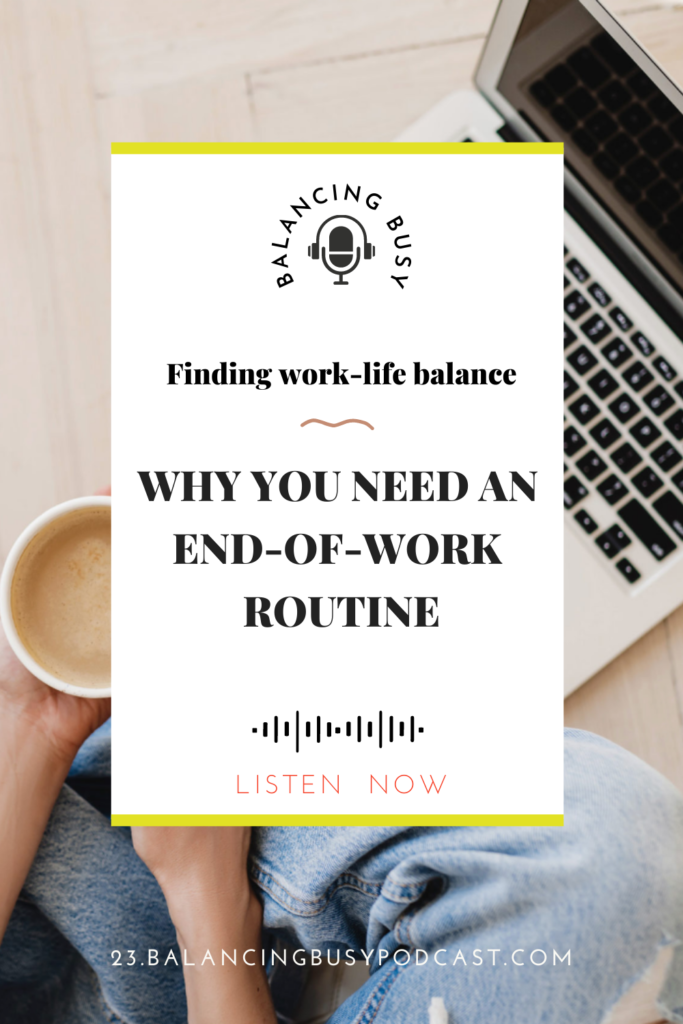
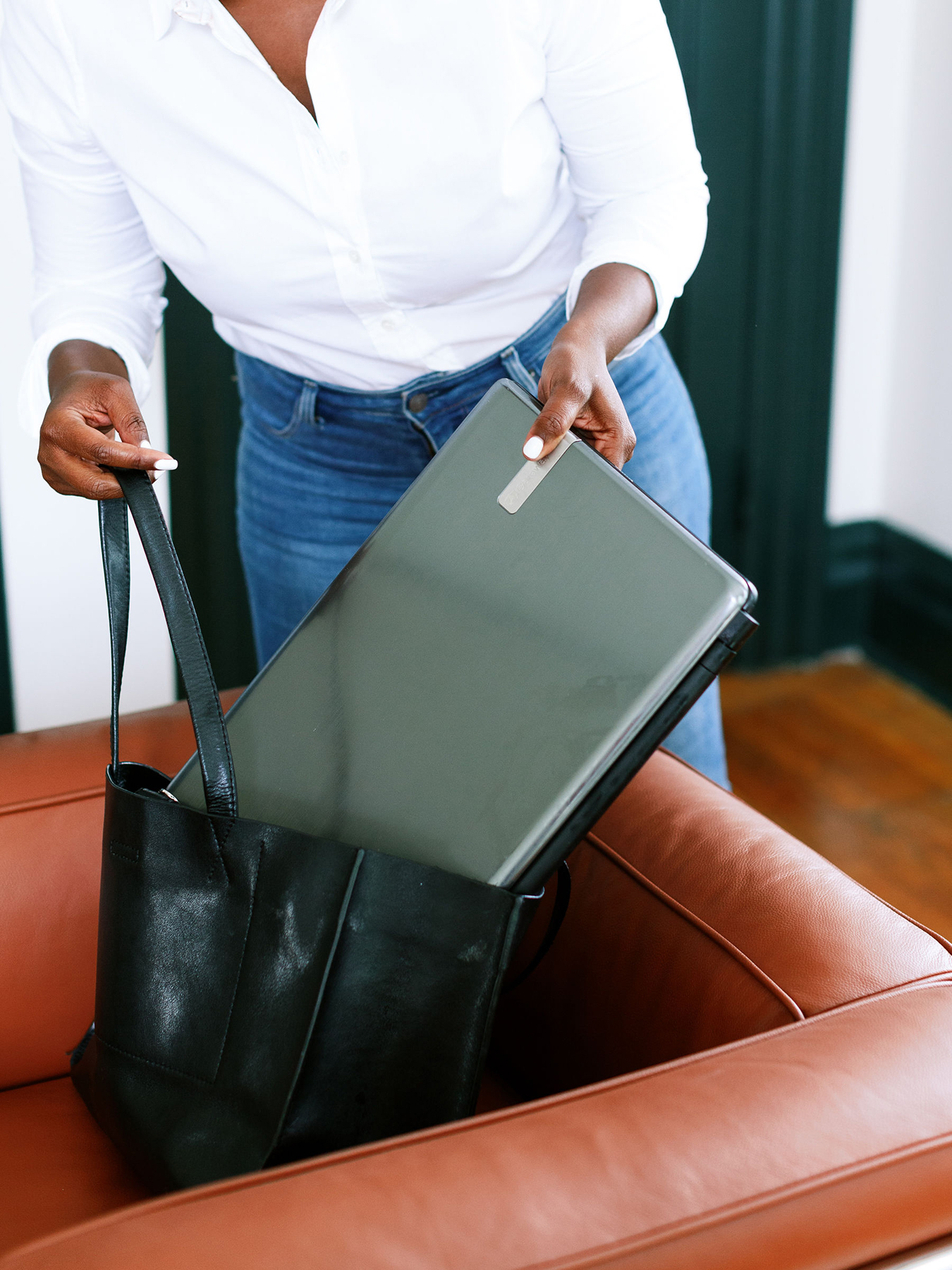
you said: